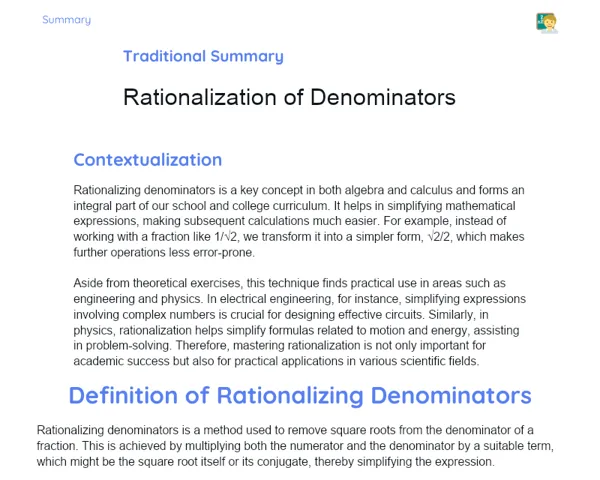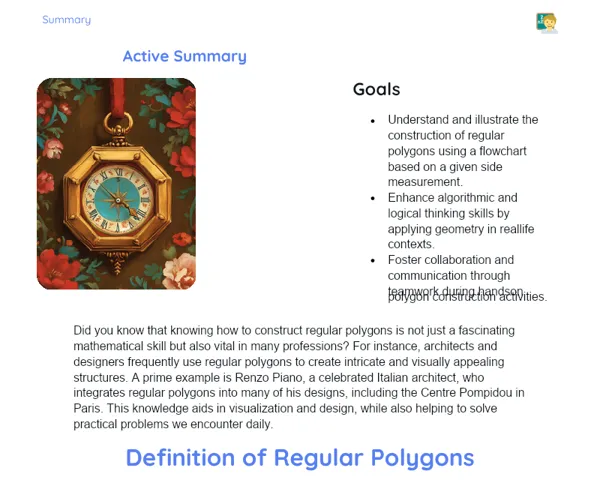Objectives
1. 🎯 Grasp the concept of angles and how to measure them in both degrees and radians.
2. 🎯 Get a handle on converting between radians and degrees, applying this knowledge in real-life and theoretical scenarios.
3. 🎯 Tackle problems related to angle conversions, especially knowing that 180 degrees equals π radians.
Contextualization
Did you know that understanding π (pi) is key when converting between degrees and radians? π is a constant that signifies the relationship between the circumference of any circle and its diameter. This constant is essential in practical applications, from understanding the orbits of planets to creating captivating computer animations. Grasping the role of π aids us in uncovering the complexities of angles and their measurements, bridging math with physics, engineering, and other fields.
Important Topics
Degrees
Degrees are a common unit for measuring angles, especially in daily life and educational settings. A full circle consists of 360 degrees, which makes it easier to comprehend and measure angles in various situations. For example, one-fourth of a circle is 90 degrees, making a right angle exactly 90 degrees.
-
Their simplicity and easy understanding make degrees the go-to choice for many practical applications.
-
Crucial for measuring and comprehending rotations and directions, particularly in navigation and engineering.
-
They form the basis for understanding other angle measurement units like radians.
Radians
The radian is an alternative measure of angle, based on the radius of a circle. One radian is defined as the angle that subtends an arc of the same length as the radius. Radians are commonly used in mathematical and physical calculations as they simplify various formulas and trigonometric relationships, particularly those related to trigonometric functions.
-
Key for calculating areas of circular sectors and arc lengths.
-
Enhances the use of trigonometric functions in various applications, like physics and engineering.
-
Understanding the conversion between radians and degrees is essential for applying many mathematical and scientific concepts.
Conversion between Degrees and Radians
Being able to convert between degrees and radians is crucial for mathematicians and scientists, as they often need to work with both units in the same discussion. The conversion is simple: 1 radian equals 180/π degrees and 1 degree equals π/180 radians. This relationship allows for quick calculations when converting from one system to another.
-
Provides flexibility when using various measurement units in math and science.
-
Fundamental for tackling real-world problems involving angles across different fields like physics and engineering.
-
Mastering this conversion widens the range of mathematical tools available for problem-solving, making calculations more efficient and precise.
Key Terms
-
Angle: The space formed between two lines that meet at a common point known as the vertex.
-
Radian: A unit of angle measurement defined by the length of an arc equal to the radius of the circle.
-
Degree: The widely used unit for measuring angles, where a complete circle consists of 360 equal divisions.
For Reflection
-
How can understanding angles in radians assist in mathematically modelling natural phenomena, like planet movements?
-
Why is it vital for engineers and architects to be proficient in converting angles between degrees and radians?
-
How does employing radians in trigonometric calculations streamline problem-solving in mathematics and sciences?
Important Conclusions
-
🌟 We’ve grasped the concept of angles, exploring both their degree and radian measurements, which are essential for various practical and theoretical applications.
-
🌟 We’ve mastered the conversion of angles between degrees and radians, a vital skill useful in diverse fields ranging from physics and engineering to pure mathematics.
-
🌟 We discussed the significance of π (pi) and its crucial role in angle conversion and calculation, linking mathematics to other disciplines.
To Exercise Knowledge
- Calculate the height of a building using a protractor, knowing the angle at which you are observing. 2. Design a treasure map with different angles where 'hunters' must convert from degrees to radians to find the treasure. 3. Sketch a bicycle wheel and determine the number of spokes, with the angle between two adjoining spokes measuring 15 degrees.
Challenge
🚀 Math Astronaut Challenge: Picture yourself on a space mission, needing to calculate the trajectory towards an asteroid. Convert the distance around the asteroid into radians. Then transform these radians into degrees and identify the correct direction for the approach. The one who makes the most accurate calculation wins the challenge!
Study Tips
-
📚 Regularly practice converting angles, whether through textbook exercises, math apps, or by observing angles in nature and attempting to convert them.
-
🔍 Watch videos and online simulations showcasing real-world applications of angles, like flight mechanics or navigation, to appreciate their practical relevance.
-
📏 Use geometric drawing tools or math software to visualize and manipulate different angles, enhancing your understanding and application of angle conversions.



